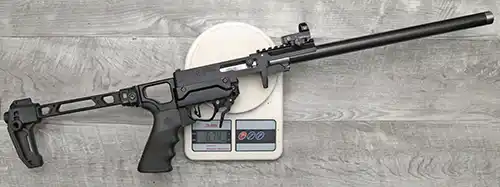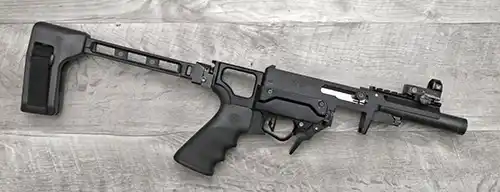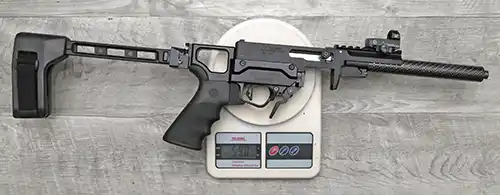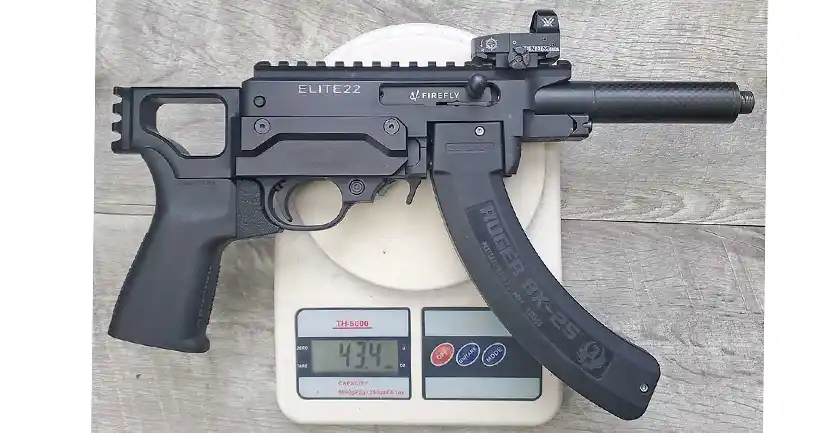When it comes to chassis options, the Spectre Superlite 10/22 Chassis from Spectre Ballistics International is aptly named. At just 6.9 ounces (195 grams), it’s extremely light. Over the past several weeks, I have used it as the foundation for a few rifle and 22 Charger builds using barrels from under six inches to standard 16″ rifle barrels. I’ve also tried a few different receivers with mixed results. It’s not perfect, but if you can work around some of the issues I encountered, it’s got potential.
First up, the Spectre Superlite 10/22 Chassis features and details
Despite the light 6.9-ounce weight, this chassis has plenty of features. At the rear is a three-slot Picatinny mount for stocks or braces. It accepts standard AR-style grips with or without a beaver tail. There’s an included gap filler for OEM trigger housings as well. Receiver compatibility includes OEM Ruger, Brownells, Dlask, and SBI’s own receivers. For those not familiar, Dlask and SBI are both Canadian brands.

Deviating from traditional chassis design, the Spectre Superlite 10/22 chassis is extremely minimalist. It’s the usual 6061-T6 aluminum, but instead of the standard action screw through the base, it attaches in a somewhat unique fashion. Replacing the receiver pins with threaded pipes, four screws keep it all together. A matching buffer pin is included as well. Color options include black and tanodize.
Assembly of the chassis, and installation
Buying my chassis pre-owned meant that I got to skip a few steps. Here’s the full instructions, if you’re interested. Basically, the trigger gap filler is screwed into the grip mount, then the grip mount is attached to the underside of the chassis. From there, it’s easy enough to add your favorite AR-style grip. No grip screw is included, because grips are different, and the grip should come with the correct screw. It’s the next step where things got a little messy for me.

Installing the threaded receiver pins may require sanding them down a bit in a drill. They have to fit the receiver snugly, but not too tight. Once the trigger group is attached to the receiver, it should drop right into the chassis. I got a good fit with the first receiver I tried, and then used the four included screws to finish the installation. I decided to forgo the steel buffer, using a polymer one in its place. I’ll modify a bolt-on polymer unit later. Using a steel pin when there’s a suppressor at the other end doesn’t make sense to me.
Some variations I built with the Spectre Superlite 10/22 Chassis
Using a Summit Precision carbon fiber rifle barrel and a Strike Industries stock, I assembled a light and fast rifle that would have been suitable for plinking or Steel Challenge. This is where this chassis really shines. Especially with the optional handguard. If you’re looking to build a lightweight, minimalist rifle on an OEM receiver, it’s a great option.

However, I realized that I wasn’t truly taking advantage of the “Superlite” design of the chassis. So I tossed the stock, threw on my stubby (5-3/8″) Summit Precision barrel, and swapped the bolt for a Volquartsen Firefly 2.0 bolt. This resulted in a Charger that weighed well under three pounds, with an optic (Vortex venom). Adding a suppressor and a 15 round magazine, it was right around three pounds. With a fully loaded ten round magazine, it was still under three. Now we’re talking light!
So what are the faults of the Spectre Superlite 10/22 Chassis?
Threading the cross pins seems like a good idea in theory. Doing so makes it a royal pain to take apart. And I was willing to overlook that for a while. Tightening the screws caused the pins to get pulled to one side or the other, and they would drag against the inside of the chassis. Eventually, they got stuck, and I finally gave up and had to knock them out with a punch. Most users are probably not going to switch between three different receivers, so this may not be an issue. But I ended up buying shorter pins and longer screws, and have not had any problems since.

Installing a TandemKross Manticore trigger leaves an odd gap. I’m certain that a Volquartsen trigger wouldn’t fit at all. Trying my KIDD and Timney triggers never happened, as this chassis is more about speed than precision. Fitting the handguard when using a Tactical Solutions Elite22 receiver required a bit of filing on the interior of the handguard. Looking back, this was somewhat regrettable, as that was only an issue with that receiver. Finally, the handguard fits a 0.920″ barrel very closely. Tucking a suppressor in there doesn’t leave much room on either side. With the longer Summit Precision Charger barrel, it’s okay. I ditched the handguard completely when using the shorter barrel.
None of these are dealbreakers, just things I ran into that I wasn’t expecting.
Final thoughts
Building a light and fast rifle is where the Spectre Superlite 10/22 Chassis really shines. That seems to be the original intent, and if that’s what you’re after, it will serve you well. Throwing together a scoped rifle with this chassis doesn’t make as much sense to me, as the rear Picatinny rail limits your stock options. Chasing the lightest 22 Charger build is another viable option, and I had a fun time with that approach.
Pricing as of publication date is $179.95 (Canadian) on the spectreballistics website. Our friends at sapoutfitters.com are offering it at $119.95 (US dollars), and code “industryoutsider” will save you an additional 5%.
